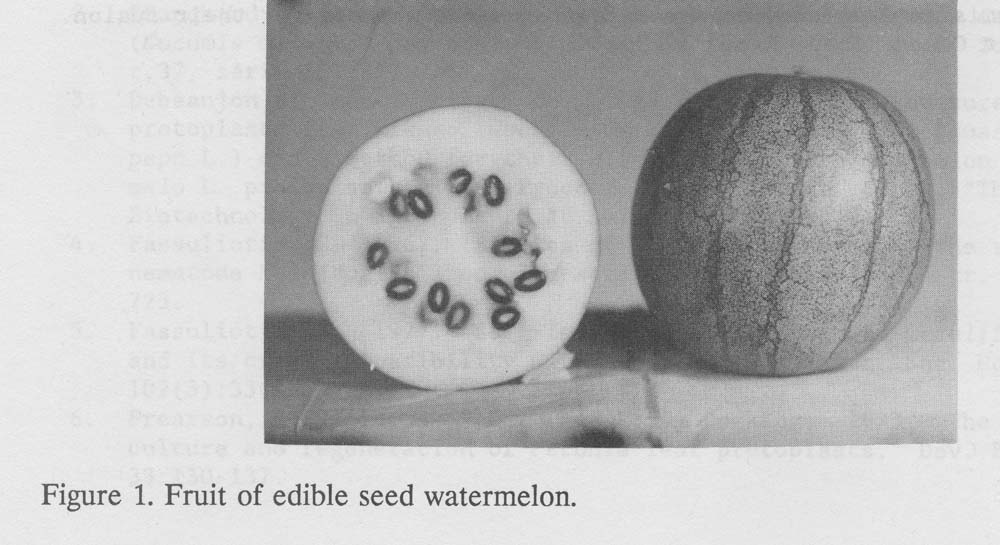Cucurbit Genetics Cooperative Report 13:40-42 (article 15) 1990
Xing-ping Zhang
Department of Horticulture, Northwestern Agricultural University, Yangling, Shaanxi, Peoples’ Republic of China
Yi Jiang
Lanzhou Horticulture School, Lanzhou, Peoples’ Republic of China
Northwest China is a major production area for melons (Cucumis melo L.) and fleshy watermelons, due to the high temperatures, intensive sunlight, and the extremely dry summer climate. In addition, this is a very important production area for watermelon grown for edible seeds. Early edible seed watermelon production and varieties were described in the “Gaolan County Record” of 1994 (1), thus there has been production in Northwest China for over 200 years. Presently, edible seed watermelon is an important economic crop in this region. In 1988, the edible seed watermelon production area and total seed yield in Gansu province were 266,000 mu (6 mu = 1 acre) and 22,636 tons, respectively (data provided by the Gansu Melon & Fruit Company).
Edible Seed Watermelon Varieties in Northwest China
Edible seed watermelons can be divided into two types based on seed coat color. Varieties with red seed coats are distributed mainly in other areas of China, especially South China. Edible seed watermelons in Northwest China, for the most part, have seeds with a black margin and white or yellowish center (Fig. 1). There are four common varieties of white-black seeded, edible seed watermelons in Northwest China. All of these varieties have good storage and shipping quality, and have good adaptability throughout the area.
Figure 1. Fruit of edible seed watermelon.

‘Hetaopi’ is a late maturing, popular variety which produces round fruits of about 3 kg. The light green skin is ornamented by 10 or more wide pencilled line-type bands, with a ring thickness of 0.9 cm. The yellowish sour flesh is of poor quality with a soluble solids content (SSC) of 4%. Fruits ripen 55 days after pollination, with the total developmental period more than 120 days. There are 250 or more seeds per fruit with a 1000-seed weight of 260 g. The seeds are 1.65 cm in length and 1.1 cm in width.
- ‘Green Skin’ is a late maturing variety in which the fruit ripens 55 days after pollination, and total plant development takes over 120 days. The fruit is round and weighs about 3 kg, with light green skin and 8 to 10 narrow pencilled line-type bands. The rind is 1 cm thick, and the slightly sweet white flesh contains 4.8% soluble solids. There are 300 seeds per fruit, with a 1000-seed weight of 210 g or more. Seed length and width are 1.6 cm and 0.95 cm, respectively.
- ‘Dark Skin’ is a late maturing variety with fruit development and plant maturity of 55 days and 120 days, respectively. Fruits are round and weigh about 2.5 kg, with sour tasting white flesh of poor quality (SSC=4.5%). There are about 250 seeds per fruit, with lengths and widths of 1.5 cm and 0.95 cm, respectively, and a 1000-seed weight of 230 g.
- ‘Striped Skin’ is a late maturing variety with the same developmental periods as the above described varieties. The fruits are round and weigh about 3.5 kg. The skin is green and smooth with 10 dark green stripes. The flesh is white and somewhat sweet, with a SSC of 4%. There are 320 or more seeds per fruit, with a 1000-seed weight of 210 g, and a seed length of 1.65 cm and a seed width of 1.1 cm.
Production Practices for Edible Seed Watermelon
Traditional cultural practices are very simple. Farmers sow seed after the last frost and wait until senescence to harvest fruits. There is almost no management throughout the season, and seed are collected when farmers have free time.
Only recently has research begun on cultural practices, and seed yield has been shown to be affected by horticultural management. Higher seed yields (202.3 kg/mu) were obtained by using a plastic film for mulching, adding 10 to 15 kg/mu phosphorus (P2O5), and increasing the plant density (3000 to 4000 plants/mu) (2,3,4).
Potential for Edible Seed Watermelon Improvement
Existing varieties are highly heterogeneous and express great diversity for seed size and other horticultural characteristics. It appears that the most important economic character, 1000-seed weight, can be greatly improved by using simple selection. Lines with 1000-seed weight as high as 340 g have been produced and placed in commercial production (3), verifying the potential for genetic improvement of seed yield. Development and utilization of F1 hybrids might also accelerate commercial edible seed watermelon production in Northwest China.
Edible seed watermelon breeding projects have been initiated at the Melon Research Center of Gansu Agricultural University and the Lanzhou Agriculture Research Institute. In addition to seed yield, resistances to Fusarium wilt, anthracnose, and gummy stem blight are being sought. A few desirable breeding lines have been developed.
Literature Cited
- Fan, Z. 1774. Gaolan County Records (book).
- Niu, Y. Z. 1989. Techniques of high yield plastic film mulching seedy watermelon production. Gansu Agriculture Scientific Technique. No. 5.
- Qin, Y. T. et al. 1989. High yield seedy watermelon cultivation and extension of ‘Lanzhou Dapian’. Scientific Research Achievements and Papers of Gansu Agriculture Science. No. 3:49-52.
- Sun, B. M. 1988. Seedy watermelon growing techniques. Cucurbit Scientific Communication. No. 1:38-39.
- Wei, D. Z. et al. 1987. Melons in Northwest China (book), p. 79-80.